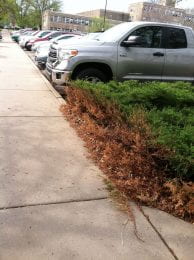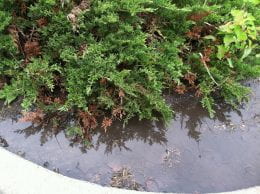By: Judy O’Mara
You can drive to any grocery store, fast food restaurant or mall in Kansas and see a spreading juniper shrub planting. They are pretty well adapted to Kansas but a few problems show up.
Winter damage is common following cold temperatures and desiccating winter winds. Die back tends to show up on the ends of the branches during December through February. If the damage isn’t too bad, it can be pruned out and with some added care, the shrubs may recover.
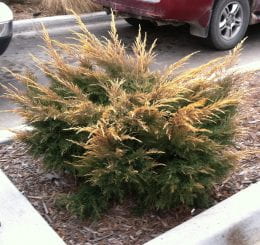
Snowy and Salty
In addition to cold temps last winter, there was lots of snow. According to Assistant State Climatologist, Mary Knapp, Manhattan Kansas received 27.8” of snow during the recent winter, which is 11.1” over the normal 16.7” snowfall. So what does this have to do with junipers? Well, with snow comes slippery sidewalks and driveways, which in turn can lead to the use of salt or de-icing products. They work pretty well to keep people safe slipping and breaking a hip, but sometimes the products can damage nearby shrubs.
It is not uncommon to see salt damage or browning on the side of juniper shrubs closest to the sidewalk in the spring. In this case, salt leached from the sidewalk and burned the roots closest to the edge. There is a nice article on which ice melts are appropriate to use at the K-State Johnson County Extension web site. Something to keep in mind for next winter.
Pictured above on the left, the juniper shrubs are experiencing salt burn from the sidewalk. Pictured above on the right is a heavy concentration of salt crystals.
Wet and More Wet
I got caught in a down pour on a recent trip to Hiawatha, KS. The area creeks were flooded and topped the roads in a few places. It was an awesome sight, plus a little bit scary. It’s been a fairly common phenomenon this spring and there are a number of articles out there on the impact of flooding on landscape plants. I thought I would throw in my two cents, as well.
One of the more serious challenges for junipers plantings is damage due to ‘wet feet’. It is not uncommon during heavy spring storms to see shrubs floating in a pool of water. Aggravating factors may be locations with heavy clay soils that drain poorly or even locations that have a compaction layer not far from the soil surface. In either case, prolonged expose to wet soils will damage the roots and cause a collapse of the planting. I tend to think of this as center decline. Sometimes the entire plant will die, and sometimes just a portion (frequently the center). So, if a large section of the planting is going out, it may be a root health issue. Juniper shrubs never recover from this type of damage. It is really important to select a well-drained site for juniper plantings.
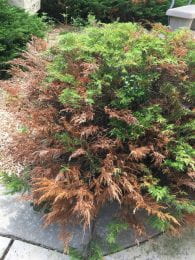

Branch Tip Die Back
I know this juniper shrub looks bad but, it’s actually okay. The damage here is caused by a fungal disease called Kabatina tip blight. It causes a die back of the branch tips, usually 2-8” with symptoms showing up between February and mid-June. It can cause a scattered branch die back or it can hit every single tip, making the shrub look like it is going to die. But no, like magic the planting recovers. By late June, the dead tips dry up and fall, slowly improving the appearance of the shrub. Some creeping junipers are particularly susceptible.

As always, there is the question ‘What can I spray?’. There are two reasons why that is not a practical option. One, the infection period is in the fall, so by the time you see the symptoms it is too late to spray. Two, the disease is basically a cosmetic issue. In most years, it shows up as scattered dead tips (barely noticeable). In years with a prolonged cool, wet spring Kabatina tip blight symptoms can be dramatic. But…summer eventually arrives and with warmer temps and drier conditions disease activity halts. At that point, the dead tips start dropping off and the planting starts to look better. So best management option? Do nothing, or maybe rip it out and plant something less susceptible.
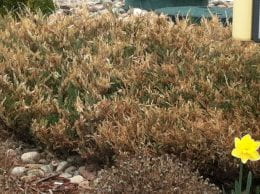
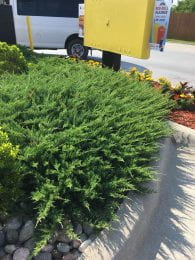
Pictured above, you can see daffodils, so you know it is early spring and conditions are favorable for Kabatina tip blight. Pictured on the right is the same planting later in the season. As you can see, all of the dead tips have dropped off of the plant.
